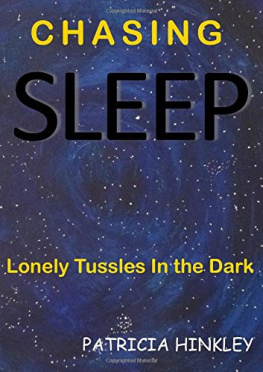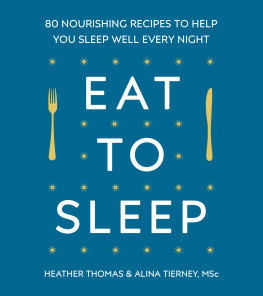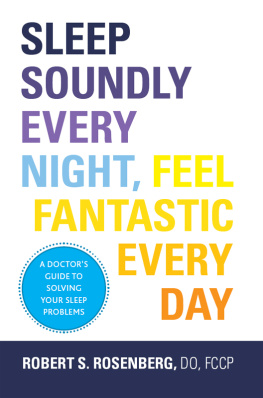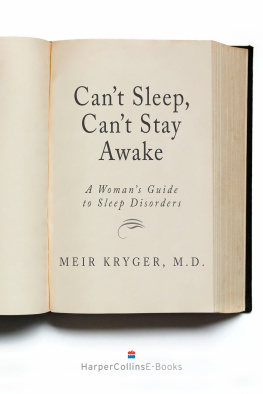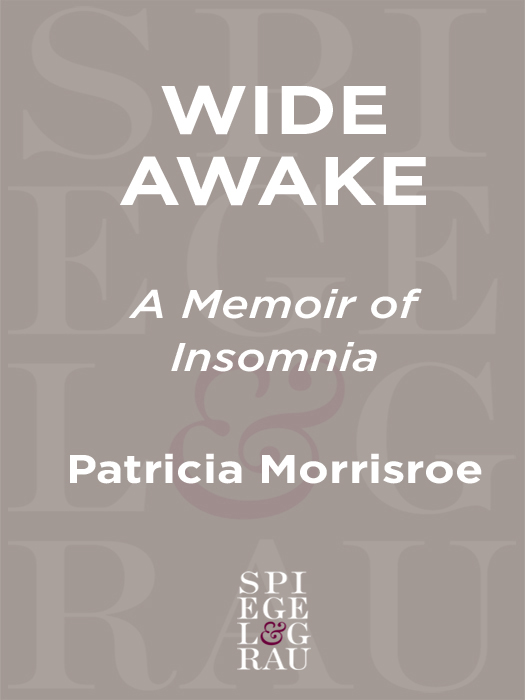For my parents and Bumpa
INTRODUCTION
Sleep broke my heart, and then it tried to kill me.
First, the heartbreak: Picture John Malkovich playing a character called Sleep based on his portrayal of the cruel, seductive Valmont in Dangerous Liaisons. He was my nightly visitorSleep, the brilliant gamesman, who delighted in torturing me. Though I consecrated my bedroom to him, banishing TV, books, and other distractions, it was never enough. He then demanded goose-down pillows and six-hundred-thread-count sheets and a high-end sound machine to provide the musical score to my sleepless nights, transporting me to the kinds of places he wouldnt be caught dead in, such as a malarial rain forest and an aviary full of screeching cockatoos.
When noise therapy failed, he began pushing sleeping pills and antianxiety medications, along with herbal remedies with deceptively soothing names, such as Beautiful Dreams and Deep Sleep. He sent me to an acupuncturist, who rebalanced my heart and kidneys, and to a pharmacy in Florence for a thirteenth-century sleeping potion that helped the Medici family but didnt help me. He suggested biofeedback and the masseuse Barbra Streisand used for her insomnia. He introduced me to a dozen psychopharmacologists and psychotherapists, including a worldly Jesuit, who was also a gynecologist and who left me wondering if I needed Prozac, estrogen, or an exorcist. Yet Sleep remained an elusive bedmate, lulling me into a state of dreamy ecstasy only to abandon me at 3 A.M. Then there were the hellish evenings when he never showed up at all, deserting me for women whose sleep systems were more robust than mine, women who, thanks to his ministrations, slept like logs. But no matter how many times he betrayed me, no matter his incessant lies and indiscriminate bed-hopping, heres the sad truth: I couldnt get enough of him.
I once mentioned to a friend that my insomnia had morphed into Malkovich as Valmont and she said, Youre joking, right? People who sleep through the night rarely think twice about the mechanics of sleep, let alone envision it as a sadistic French aristocrat, but when youve suffered the miseries of insomnia, the Sandman has a twisted mind. By withholding his affection, he can potentially shorten your life, ruin your concentration, and raise your risk of heart disease, obesity, and cancer. Sleep, in his various dysfunctions, can be one of the most dangerous liaisons of alla reality that was brought home to me one morning in the winter of 2006, when, after a particularly bad night, I went out for a latte. Not paying adequate attention, I crossed Park Avenue on a red light and, after catching a flash of yellow, steeled myself for the inevitable collision with a speeding cab. The driver slammed on the brakes within inches of hitting me. Lady! he yelled. Whats your problem?
Up until then, Id always considered myself a high-functioning insomniac with few compensatory bad habits. I limited my caffeine intake and got plenty of fresh air, taking long, invigorating walks in Central Park. While doctors have linked insomnia to obesity, I watched what I ate and never gained weight. I was so disciplined that I couldnt believe that of all things, I couldnt master the one that required the least amount of effort. What was my problem?
A few days after my near collision, I flew to London with my husband, Lee. He was going for business, while I was going on the off chance that changing time zones might shake some sense into my biological clock. (I appreciated the irony that I was now hoping jet lag would help my insomnia, but I likened it to rebooting a computer.) We checked in to the Draycott, a small country house hotel in Chelsea, where the rooms are named after famous English personalities. Id once spent a restless night in the Agatha Christie Suite listening to what I imagined was a murder in the room above, so now I opted for Gertrude Lawrence. That night, while Lee slept, I skimmed the actresss biography, which had been left on the writing desk near the bed. Lawrence had played the title role in Lady in the Dark, Moss Harts psychoanalytical musical about a fashion editor who is plagued by turbulent dreams. The character was based on Hart himself, whod spent much of his life in therapy dealing with his depression and insomnia. It occurred to me that maybe I should write about my own insomnia, a thought that naturally made me less sleepy. I moved from the bed to a wing chair, where the hotel had placed a teddy bear as an homage to Aloysius, the stuffed animal Sebastian Flyte carries in Evelyn Waughs Brideshead Revisited. Waugh had terrible insomnia, which he treated with alcohol and sleeping potionsa regimen that led to his nervous breakdown aboard a cruise ship heading to Ceylon and formed the basis of his novel The Ordeal of Gilbert Pinfold.
When I climbed back into bed, I thought of all the other famous people who suffered from insomnia, including my immediate neighbors at the hotel, Vivien Leigh, Lewis Carroll, and Oscar Wilde. I spent the next several hours convincing myself I shouldnt take sleeping pills lest I wind up like Waugh, hallucinating jazz bands and barking dogs. By 4 A.M. I didnt care and reached for the Ambien bottle, swallowing a five-milligram pill. It workedfor forty-five minutesand the next night I switched to a milligram of Ativan, which gave me a grand total of three hours of sleep.
Given my sleep-deprived state the next morning, I probably should have avoided Gothic Nightmares, an exhibit at the Tate Britain that explored the violent and supernatural themes in art and culture from 1770 to 1830. The movie Frankenstein had given me nightmares as a child, and one of the paintings in the Tate exhibitHenry Fuselis The Nightmarewas based on Mary Shelleys original story; it depicted a terrifying image of a young woman prostrate on her bed, a hideous red-eyed incubus perched on her breastbone. In the corner, a leering horse, with milky white orbs for eyes, poked its head through blood-red boudoir curtains. The woman appeared to be heavily sedated, maybe even half-dead, but at least, I noted, she was sleeping. I tried listening to the audio guide, but I was starting to crash. I heard a voice cry, Sleep, no more! Macbeth has murdered sleep! Was it the audio narrator? I followed a woman through parted curtains and sat on a bench in the darkness to watch the Phantasmagoria, an animated slide show of supernatural images with sound effects. A skeleton flew in front of me. Startled, I screamed and headed for the exit, passing through a series of crimson rooms, where I encountered one of the most unnerving paintings in the show, Fuselis Mad Kate. The portrait depicts a woman insane with grief over the death of her lover. Caught in a tempest, the wind whipping her cloak, she looked at me with the glazed eyes of someone who hadnt slept in weeks.
I went outside to get a cab. The sky had turned threatening and soon it began to pour. The wind, whipping across the Thames, turned my umbrella inside out, breaking its fragile spokes. A rational person would have returned to the Tate and waited for the weather to lift, but I was no longer rational. I was Mad Kate. With no cabs in sight and no sense of direction, I headed off in the downpour, drunk with sleeplessness, crying for poor Kate, for Vivien Leigh, for Moss Hart, for Evelyn Waughfor all of us sleepless ladies and men in the dark.




